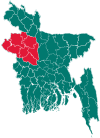Baraigram Upazila
Baraigram
বড়াইগ্রাম | |
|---|---|
| Coordinates: 24°18.5′N 89°10.2′E / 24.3083°N 89.1700°E | |
| Country | |
| Division | Rajshahi Division |
| District | Natore District |
| Area | |
• Total | 299.61 km2 (115.68 sq mi) |
| Population (1991) | |
• Total | 230,480 |
| • Density | 770/km2 (2,000/sq mi) |
| Time zone | UTC+6 (BST) |
| Website | baraigram |
Baraigram (Template:Lang-bn) is an upazila of Natore District, located in the Rajshahi Division of Bangladesh.[1]
History
The Aryan migrations to Lalpur and Baraigram date back to the Gupta period in the 5th century.[2] In the 20th century, a copper plate inscription of King Kumaragupta I was discovered in Baraigram by a Muslim farmer who handed it to Zamindar Ershad Ali Khan Chowdhury who presented it to historian Akshay Kumar Maitreya. The inscription was a land grant from the Gupta emperor to a Brahmin settler.[3]
Geography
Baraigram is located at 24°18′30″N 89°10′15″E / 24.3083°N 89.1708°E. It has 40,582 households and total area 299.61 km2. The upazila is bounded by Gurudaspur and Natore sadar upazilas on the north, Atgharia and Ishwardi upazilas on the south, Chatmohar upazila on the east, lalpur and Bagatipara upazilas on the west.[1]
Demographics
According to the 2001 Bangladesh census, Baraigram had a population of 244,821; male constituted 125,399, female 119,422; Muslim constituted 228,205, Hindu 10,296, Buddhist 6,290, Christian 13 and others 17. Indigenous communities such as Pahari, Munda, Oraon, Mahato belong to this upazila.[1]
As of the 1991 Bangladesh census, the upazila had a population of 230,480. Males constituted 50.85% of the population, and females 49.15%. This Upazila's eighteen up population is 108,842. Baraigram had an average literacy rate of 25.3% (7+ years), and the national average of 32.4% literate.[4]
Administration
Baraigram, primarily formed as a Thana in 1869, was turned into an upazila on in 1983.[1]
The Upazila is divided into Baraigram Municipality, Bonpara Municipality, and seven union parishads: Baraigram, Chandai, Gopalpur, Joari, Majgoan, Nagor, and Zonail. The union parishads are subdivided into 152 mauzas and 169 villages.[5]
Baraigram Municipality and Bonpara Municipality are each subdivided into 9 wards.[5]
See also
References
- ^ a b c d Md. Entaj Uddin (2012), "Baraigram Upazila", in Sirajul Islam and Ahmed A. Jamal (ed.), Banglapedia: National Encyclopedia of Bangladesh (Second ed.), Asiatic Society of Bangladesh
- ^ "লালপুরের ইতিহাস ও ঐতিহ্য". Lalpur Upajela (in Bengali).
- ^ Abdulhamid, Muhammad. চলন বিলের ইতি কাহিনী (in Bengali). pp. 160–161.
- ^ "Population Census Wing, BBS". Archived from the original on 2005-03-27. Retrieved November 10, 2006.
- ^ a b "District Statistics 2011: Natore" (PDF). Bangladesh Bureau of Statistics. Archived from the original (PDF) on 13 November 2014. Retrieved 14 July 2014.


